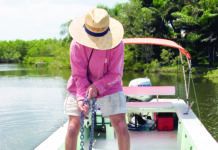Email/Internet Solutions
I read the December 1999 article on email at sea with interest as we have been looking for a convenient way to stay in touch since we started living aboard our Hylas 49 three years ago.
We judge satellite phones too expensive, and any given model soon to be obsolete. The several people weve talked to with a Magellan GSC 100 agree with your assessment: D+.
Using a laptop has been cumbersome. On the US East Coast, its hard to find a phone line, even at a marina where youve just spent $50 for dockage. In Bermuda, the Bahamas and Leeward islands, it can cost $15 or more for 2 minutes of line time. Of course, there is always the danger of transporting the laptop via dinghy.
The answer to our prayers has been PocketMail. Its a shirt-pocket-sized device with a real keyboard that emails from a phone handset (regular, cell or paystation). We found it at the US Sailboat Show in Annapolis as we were getting ready for this years run to Bermuda and the Antilles. We bought the device through Women on Board for $160, which included a one-year subscription. We loved it so much we bought two more for family members; this time for $79 at Office Max (which included one free month service-$9/month after that).
We have already been to pay phones in the Virgin Islands where three others in line had PocketMail. Weve had many questions from onlookers, mostly wanting to know where to get one.
Popular as they have become among cruisers, many more still don’t know about PocketMail and are waiting for the low-cost email solution.
PocketMail customer service is [email protected]. Im sure they would provide information on availability and etc.
Jerry & Nancy Wertzbaugher
Escapade
Virgin Gorda Sound, USVI
(sent via PocketMail)
Some time later, we received the following update from Jerry & Nancy Wertzbaugher, who are cruising the West Indies.
As reported earlier, Bermuda flawless (toll), USVI flawless (toll-free), BVI flawless (toll).
Not so good from St. Martin. Dutch side phone lines are inexpensive but not very clear (possibly owing to Lenny). PocketMail worked on 30% of attempts from Dutch phones.
French side worked much better; 80% of attempts using toll number. Cost: $6 for four messages out and 10 in.
Only three others in Simpson Bay have PocketMail, but have had four inquiries from cruisers wanting to buy one.
We will soon be reporting on our own experiences with PocketMail.
This summer I used the following with some success while on the Intracoastal Waterway.
notebook computer
3COM MHz cellular modem (33.6k baud)
special cable for Motorola phone
Motorola analog cellular phone
GTE Eastern Choice Service (100 minutes east of Mississippi)
I used Juno and Mindspring services. I found that Juno would only connect to local numbers. Mindspring connected. I usually used my St. Petersburg, Florida number. It connected at speeds from 4,800 to 10,000 baud. I was unable to connect in Key West and in southern Georgia as the cellular telephone companies there would not connect a GTE account (so much for Eastern Choice Working)
The cell phone companies want to sell you a digital service. I have not been able to find a modem that connects to US digital telephones. The European GSM digital service does have products available.
I met someone who said he sold the connections which vendors at trade shows use to connect their credit card readers to telephones. I have not been able to find this product to see if it would be a good method to connect to the Internet on a cell phone.
Fred Sellers
via email
Our Internet access needs are for coastal cruising during the spring and fall. We spend the whole summer on the boat (a Nauticat 33 pilothouse motorsailer). We send and receive email several times each day, and do about 10 hours of web research/browsing each week.
We found the most cost-effective solution is a cell telephone with a built-in modem. It communicates by infrared with our laptop computer. The price of our Ericsson I 888 World was about $300. We use Omnipoint as our service provider, because they cover our cruising area (New Eng-lands islands), and their rates seem reasonable. We pay about 10 for air time, no matter where we call. We do our browsing, and make our family calls on the weekends, when the rates are a penny a minute for calls in New England. Omnipoint does not require a long-term contract, and we are able to adjust our plan on a month-to-month basis. We use the telephone for voice communications as well.
Coty Keller
Brentwood, New York
Lifejacket Bags
Re: the lifejacket bags I recommended in the February 15, 2000 issue, but with incorrect contact information, our records show that we actually purchased them from BassPro (#55433200). They cost $10.99 plus shipping ($4.95 for first unit).
The units are heavy-duty white vinyl with zipper, handles on the end, a small ventilating mesh window, and a bright red Lifejacket sign. They are 12-1/2″ high x 20″ x 15″ deep. They arent listed on the BassPro web site, nor in the current BassPro catalogue. But they have them in stock if you order by phone-800/227-7776.
Peter Hayes
Pegasus Project
via email
Ranger 26
Thanks for your excellent article on the Ranger 26 sloop (August 1, 1999). Some of the structural weaknesses that you listed in the article may have been addressed in later production years. Specifically, the hull-to-deck joint in my 1974 Ranger 26 is through-bolted, not attached with self-tapping screws. I still have some slow leaks at the joint. However, I think (hope!) they can be solved without removing the toe rail.
Also, the mast compression load is carried athwartships by an aluminum-alloy box beam molded into the cabin top. I discovered the aluminum beam while drilling the cabin for mast wiring-it appears to be about 3″ x 3″ and the walls are about 1/8″ thick (its also a decent place to drill and tap for attaching deck hardware near the mast).
The bulkhead and compression posts under the box beam do not appear to extend into the bilge, but rest in a channel molded into the cabin sole. This structure seems to carry the mast compression without any noticeable deflection of the cabin top, and there is little opportunity for the teak to rot because it is not in the bilge.
By the way, there is a very active Ranger-boat mailing list on the Internet; for more information, send email to [email protected] (no subject or body needed in the email).
Michael Mraz
Seattle, Washington
Wax Over New Glass
I am writing this in response to your article on fiberglass restorers (April 15, 2000). I have been using New Glass for the past eight years or so on my 1974 Catalina 27. I am located in the Northeast United States and sail on Lake Ontario. My experience has been that if you use New Glass its effective life can be extended to about three or four years with the simple step of waxing. I coat the topsides with the five coats of New Glass and then put a coat of wax over top of the New Glass. A new coat of wax every season will keep the shine in excellent shape. Be sure to use a wax that doesn’t have a cleaning compound or you just end up taking the New Glass off a little at a time.
Steve Schultz
via email
Where Credit Is Due…
To Statpower, Brunaby, British Columbia: I recently returned my 800 Prowatt Inverter to Statpower because I had accidentally connected the output to a live power supply. I forwarded the damaged unit to them and they returned to me a new (to me ) unit at no charge although discussions with them had indicated that there would be a charge for a rebuilt unit.
Ramsay Murray
Victoria, British Columbia
To Hellamarine, Peachtree City, Georgia: I have 10 Hella fans on my boat and when in the Canal Zone put them to good use. After several years of use they started to have problems. I called Hella and explained that for a high-dollar fan I should expect better service life. They agreed and told me the new fans have a 5,000-hour motor and not the old 2,000-hour motor.
The long and the short of it is I sent back four worn-out fans and they replaced them and sent me two more for my trouble. Im happy to do business with a firm that stands behind its product and also has the end consumer in mind.
Tom Kenney
Annapolis, Maryland




































